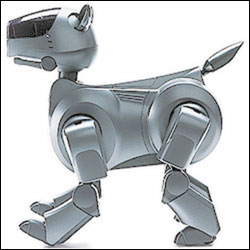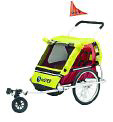Humankind is on a collision course with the machine race. We know, for instance, of at least one futuristic warrior robot that will travel back in time and do well in California politics. Until that apocalyptic day, however, we should love those robots among us or, at least, exploit them. For years, robots have been assembling our cars, descending into volcanoes, and scraping up hazardous materials. Now they are insinuating themselves into our private lives, making George and Jane Jetsons of us all.
Robotics manufacturers are moving beyond the old, motor-driven, solenoid-powered models of yesteryear. Today’s robots for home and office are employing the same streamlined, state-of-the-art technologies that have allowed us to send robots skittering across Martian soil and use them to perform delicate microsurgeries and carry heavy objects over vast distances.
There are robots that will mow your lawn and clean your floorand do a good job of it. The Roomba Pro Elite Robotic Floor Vac ($249.95 at Sharper Image, or from the source: www.roombavac.com) is a fantastic device that automatically sweeps and vacuums up dirt, pet hair, and dust while you’re busy watching Dr. Phil. An adjustable timer lets you customize the Pro Elite’s run time (calculated to cover your entire floor space), a side brush clears baseboards and corners, and a spot cleaning function addresses areas that need extra attention. A rechargeable battery is good for 90 minutes of hands-off cleaning.
Meanwhile, you can master the work outdoors with Robomower (Friendly Robotics, $699 at www.robotic-lawnmower.com), a backyard buddy that cuts grass within an area you define with perimeter wire. A big hit in Europe, Robomower is electrically powered, nonpolluting, and quiet enough to operate at night. A triple- chamber mulcher recycles your lawn’s valuable nutrients, and various child- safety mechanisms prevent kids from starting the machine or losing fingers during operation. The Robomower also detects obstacles like rocks and stumps.
Interested in a more ubiquitous robot? A robot with more presence? Perhaps a personal assistant is the thing. Evolution Robotics’ ER1 ($249 at www.evolution.com/er1/) is an economical and mobile helpmate that operates with your laptop while tracking objects through different environments, photographing or capturing video of events, watching the house while you’re away, and taking your directions via e-mail. The ER1 has voice- and face-recognition capabilities and can be reconfigured to accommodate various accessories.
A far more sophisticated personal robot is Cye-sr (Probotics, $2,995 at www.personalrobots.com), a sweet little low rider that accomplishes a wide variety of tasks, from housecleaning and delivering mail to escorting visitors to your waiting room. Cye is guided by a graphic user interface run on any PC, can drive over any type of floor, learns how to navigate a house within minutes, and moves at a let’s-scare-Fido-to-death brisk clip of 3 feet per second. Like the ER1, Cye can make security rounds of your digs while you’re away, constantly e-mailing images of your rooms or of the kids’ activities. Cye’s most attractive feature, however, is that its design is “open”it can be modified to meet almost any need of an imaginative owner.
Maybe a robot that knows how to hold up its end of a relationship is what you’re after. Sony’s ever-expanding series of AIBO robot dogs is an extraordinary product line that offers many of the advantages (and none of the disadvantages) of owning a real pet. The caramel brown ERS-31L ($599 at the Discover Channel Store, Bellevue Square) sort of looks like a sweet bulldog, recognizes and responds to 75 voice commands, performs 200-plus dance moves, and walks through this world with more curiosity than some American presidentssnapping downloadable photographs of interesting phenomena. Expressive sensors in its head, paws, and tail communicate a wide variety of emotions (happiness, fear, etc.) and canine needs (play, hunger, search).
Sony’s ERS-210 series ($1,299) is faster, exhibits more functionality, and actually learns and grows through interaction with its owner and environment. The ERS-220A ($1,299) does all that in a more robot-y, sci-fi body, but it’s the new, state-of-the-art, pearl-white ERS-7 ($1,599, www.sonystyle.com) that offers the most autonomous behavior and fun, including optional mature-dog or puppy modes.
But wait. Perhaps we’re getting ahead of ourselves. Wouldn’t it be better to understand the souls of robots before they understand our own? Inexpensive robot kits are the answer, great for hobbyists, students, and computer programmers looking for something new to do.
Arrick Robotics offers A Robot ($235 at www.robotics.com/arobot), a computer-controlled mobile ‘bot suitable for unlimited experimentation and training in programming, motion control, path planning, and object avoidance. It’s easily assembled with common tools.
The nonprofit, Oklahoma-based KISS Institute for Practical Robotics (www.kipr.org), a big booster of the robotics sport Botball, sells a Botball Kit ($1,250) that provides hours of practical training for organized teams. But they also offer the incredibly cute BYO-bots ($25), a tabletop robot that interacts with people via a flashlight beam.
Don’t overlook the ever-reliable, enormously fun, accessible, and affordable LEGOs robotics kits ($60-$200), called Mindstorms and Spybotics (Toys “R” Us or www.lego.com). These are great for kids and adults who know the truth: The Metal Ones are our destiny.








